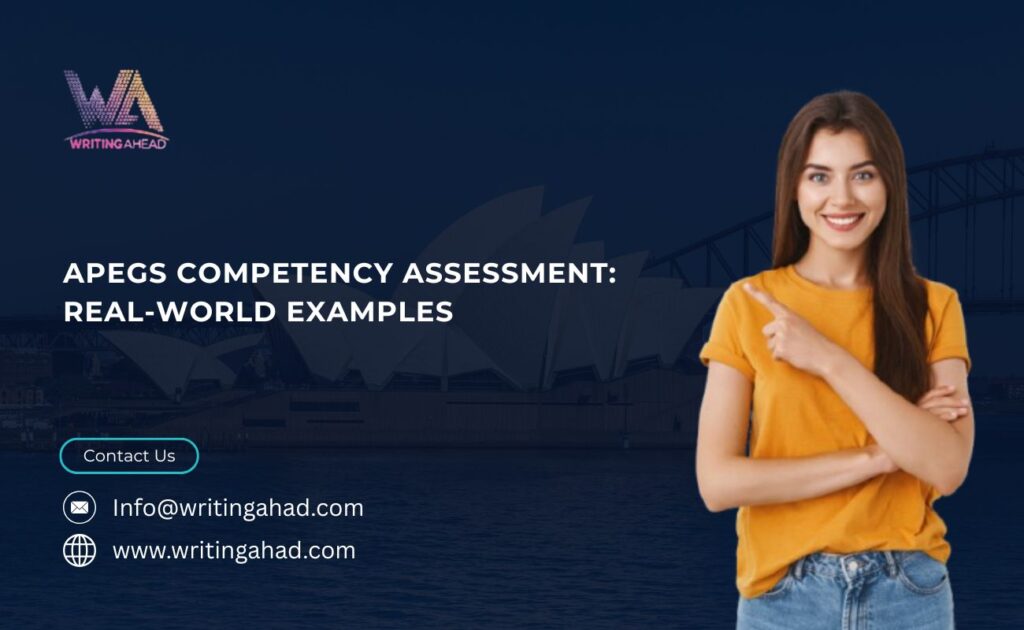
apegs competency assessment
The APEGS Competency Assessment is an essential stage for engineers and geoscientists aiming to gain professional recognition. It helps assessors determine whether applicants meet the standards required for independent practice. A well-prepared APEGS Report not only validates your technical skills but also reflects your ability to handle ethical, leadership, and communication responsibilities in real-world environments.
This article explores real-world examples that illustrate how professionals can effectively present their competencies. It breaks down the key elements of the assessment process, offers insights into strong examples, and provides detailed guidance for crafting a compelling submission.
Understanding the APEGS Competency Assessment
The Purpose of the Assessment
The apegs competency assessment measures an applicant’s capability to practice safely and independently. It assesses both technical proficiency and soft skills through examples drawn from professional experiences. Assessors examine the depth of engineering judgment, adherence to ethical standards, and application of technical knowledge in various work contexts.
Importance of Real-World Examples
Real-world examples bridge the gap between theory and professional application. They demonstrate not just what you know but how you apply that knowledge to solve engineering problems, manage projects, and ensure public safety. Effective examples make the APEGS Report stronger, convincing reviewers of your readiness for professional practice.
Key Competency Categories Explained
The APEGS system evaluates your experience across several core areas. Understanding these categories helps in selecting relevant real-world examples.
Technical Competence
This involves applying engineering principles, conducting analysis, and implementing solutions. Examples should showcase your problem-solving approach, decision-making skills, and ability to manage complex projects effectively.
Communication Skills
Engineering is not only technical—it also requires clarity in communication. Examples should reflect how you have presented reports, led meetings, or collaborated with interdisciplinary teams.
Project and Financial Management
Examples in this area should highlight your ability to manage resources, budgets, and schedules. Demonstrating control over project scope and effective decision-making adds value to your apegs competency assessment.
Teamwork and Leadership
Assessors look for proof of your leadership and mentorship qualities. Examples may include supervising junior staff, coordinating with contractors, or leading cross-functional teams.
Professional Accountability
This area evaluates your commitment to ethical and regulatory standards. Strong examples involve handling safety issues, maintaining compliance, and demonstrating integrity in engineering decisions.
Real-World Example 1: Managing Structural Design Challenges
Situation
An Australian student working in a civil engineering firm was assigned a project to redesign a steel structure after discovering misalignments during construction.
Action
The engineer conducted a root-cause analysis, reviewed design calculations, and coordinated with architects and contractors. A revised model was proposed, reducing load risks and improving alignment tolerances.
Result
The updated design met safety standards, minimized cost overruns, and restored stakeholder confidence. This example effectively demonstrates technical competence, leadership, and communication skills within the APEGS Report framework.
Real-World Example 2: Implementing Environmental Solutions
Situation
In an environmental engineering role, the applicant managed a wastewater treatment upgrade to meet new regulatory standards.
Action
The engineer evaluated existing systems, designed an improved treatment process, and implemented a monitoring mechanism to ensure long-term compliance.
Result
The plant achieved 95% pollutant reduction, enhancing sustainability performance. This real-world scenario clearly aligns with technical expertise, project management, and professional accountability competencies within the apegs competency assessment.
Real-World Example 3: Improving Process Efficiency in Mining Operations
Situation
A mining engineer identified inefficiencies in material handling that caused frequent equipment downtime.
Action
By analyzing process flow and introducing predictive maintenance tools, the engineer optimized performance and reduced downtime by 20%.
Result
This example shows innovation, analytical thinking, and financial management. It fits well in the APEGS Report to demonstrate value-driven problem-solving and leadership capabilities.
Real-World Example 4: Strengthening Safety and Risk Management
Situation
A mechanical engineer noticed recurring safety incidents involving pressure vessel maintenance.
Action
They conducted a hazard assessment, introduced new safety checklists, and trained maintenance personnel on updated procedures.
Result
The incident rate dropped by 40%. This real-world case effectively illustrates professional accountability, teamwork, and ethical responsibility — all essential for the apegs competency assessment.
Real-World Example 5: Optimizing Project Cost and Delivery
Situation
An electrical engineer was leading a substation expansion project that faced cost overruns and material delays.
Action
They renegotiated supplier contracts, introduced a just-in-time inventory system, and restructured the project schedule.
Result
The project was delivered within the revised budget and on time. This strong example demonstrates financial management, leadership, and adaptability under pressure, key factors in any successful APEGS Report.
How to Select the Right Examples
Relevance and Impact
Select experiences where your contribution had a measurable impact. Focus on complex problems that require independent judgment and professional decision-making.
Breadth of Experience
Use examples from various projects to show diverse competencies — technical, managerial, and ethical. The apegs competency assessment values a well-rounded professional journey.
Quantifiable Results
Include outcomes supported by measurable data such as cost savings, efficiency gains, or risk reduction. Numbers provide credibility and help assessors understand the scale of your work.
Structuring Your APEGS Report
Introduction and Overview
Start your APEGS Report with a concise introduction describing your engineering background, areas of expertise, and overall project exposure.
Competency-Specific Narratives
For each competency, present an example using the STAR method (Situation, Task, Action, Result). Keep your responses detailed yet concise, and emphasize your personal role in achieving the outcomes.
Professional Reflection
Reflect on lessons learned, challenges faced, and how these experiences enhanced your professional growth. Reflection demonstrates maturity and self-awareness — critical elements in the apegs competency assessment.
Common Mistakes to Avoid
Lack of Specificity
Avoid generic statements. Provide clear examples that highlight your direct involvement and responsibilities.
Ignoring Soft Skills
While technical skills are vital, leadership and communication examples are equally important. Assessors value professionals who can collaborate effectively.
Overly Technical Language
Keep explanations clear. Your APEGS Report should be understandable to assessors from varied engineering backgrounds.
Insufficient Evidence
Support your claims with data, outcomes, or recognition received. Evidence strengthens credibility and demonstrates accountability.
Tips for Crafting a Strong Submission
Use Action-Oriented Language
Words like “designed,” “implemented,” and “analyzed” create impact. They emphasize your proactive approach.
Stay Within Word Limits
Concise yet comprehensive examples show discipline in technical writing — a key trait valued by assessors.
Review and Refine
Seek feedback from peers or mentors before final submission. A fresh perspective can identify areas for improvement and enhance the clarity of your apegs competency assessment.
Reflecting on Your Engineering Growth
Real-world examples are not just about meeting requirements; they reveal your evolution as an engineer. Each situation you describe should demonstrate learning, adaptability, and growing professional judgment. Through these examples, assessors can see how your experiences have shaped your approach to ethical and safe engineering practice.
Conclusion
The APEGS Competency Assessment is more than a formality — it’s a professional journey that allows engineers to demonstrate their readiness for independent practice. Crafting a compelling APEGS Report with strong real-world examples provides clear evidence of your technical mastery, leadership, and ethical standards. By thoughtfully presenting diverse, impactful scenarios, you position yourself as a confident professional ready to contribute meaningfully to the engineering community.
FAQs
What is the main purpose of the APEGS competency assessment?
The apegs competency assessment evaluates whether an applicant possesses the technical expertise, ethical understanding, and leadership skills required for independent engineering practice. It ensures that professionals can handle complex problems responsibly while maintaining public safety and following industry standards.
How many examples should I include in my APEGS Report?
Typically, applicants provide multiple examples — at least one for each core competency category. Each example should demonstrate different aspects of your engineering ability, from technical proficiency to project management and communication. Quality and clarity matter more than quantity.
Can I use academic projects in my APEGS Report?
Academic projects can be used only if they demonstrate substantial professional-level work. However, the APEGS Report should primarily focus on real-world professional experience that showcases independent decision-making, accountability, and engineering judgment.
How detailed should my real-world examples be?
Each example should include context, actions taken, and measurable outcomes. Be specific about your individual role, challenges faced, and results achieved. The aim is to show practical application of skills, not just describe tasks or project goals.
How can I make my APEGS Report stand out?
To make your APEGS Report stand out, focus on clarity, structure, and authenticity. Use real results, emphasize personal contributions, and reflect on what you learned. Review thoroughly to eliminate errors and ensure every example aligns with APEGS competency standards.


